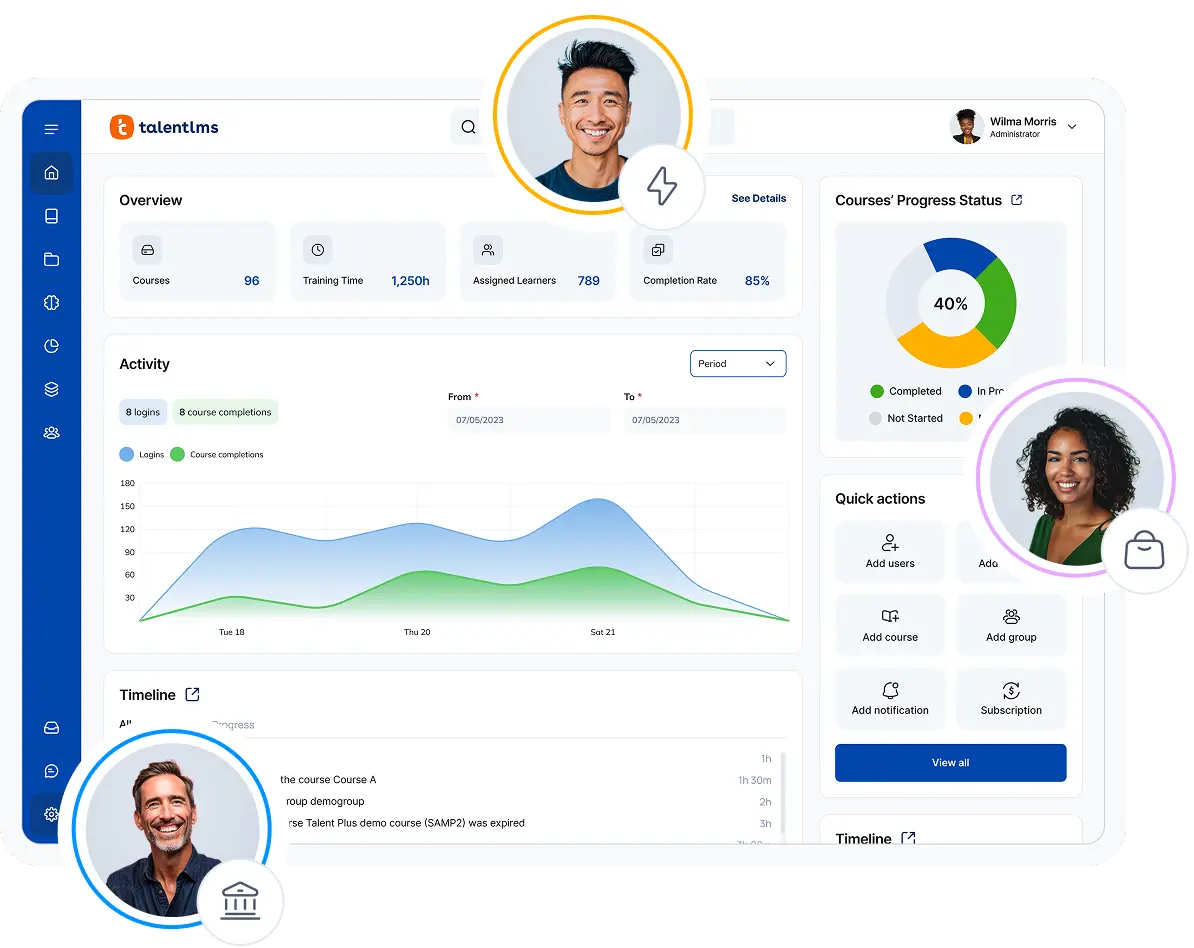- What is National Employee Appreciation Day?
- What is the meaning of employee appreciation?
- 10 employee appreciation ideas your workforce will love
- What’s the ROI for employee appreciation?
- How to measure employee appreciation ROI
- What is the difference between recognition and appreciation for employees?
- Employee appreciation equals workplace success
Showing your employees how much they’re appreciated isn’t just for Employee Appreciation Day. You can (and should) make your team feel valued every day of the year. Because it’s not directly linked to business KPIs, companies don’t always work to find effective employee appreciation ideas.
But, it turns out, making the effort to recognize your employees does matter to your business’s success.
To illustrate, consider this experiment run by researchers Christiane Bradler, Robert Dur, Susanne Neckermann, and Arjan Non. They hired over 300 employees to do a basic data-entry task for three hours. After two hours, a random sample of work groups received unexpected recognition for a job well done.
Researchers saw increased productivity and work quality among those groups where praise was offered—even by those employees who didn’t directly receive the praise! If you want a more loyal, motivated, and high-performing workforce, it’s time to emphasize employee appreciation.
Key takeaways
- Employee appreciation leads to higher productivity, increased job satisfaction, and better collective morale.
- It’s crucial to regularly appreciate and recognize employees. Make it a part of everyday interactions and company culture.
- Use a mix of ways to show appreciation. Personalized thank-you notes, flexible work models, and L&D opportunities are amazing ways to achieve this.
- Appreciate your remote teams, too. Use technology to boost team collaboration and interaction that leads to virtual recognition.
What is National Employee Appreciation Day?
People usually celebrate National Employee Appreciation Day on the first Friday in March. It was founded by Dr. Bob Nelson, a founding member of Recognition Professionals International, in 1995.
This day was initially created by Dr. Nelson to celebrate the publication of his book, 1,001 Ways to Reward Employees. But soon after, this day became a strong reminder for employers to recognize and appreciate their employees for their hard work, dedication, and contributions to the organization.
National Employee Appreciation Day motivates companies to create a culture of active recognition. According to Dr. Nelson, when organizations celebrate Employee Appreciation Day it’s easier to enhance morale, team relationships, retention, performance, and talent attraction.
What is the meaning of employee appreciation?
Showing appreciation means recognizing and acknowledging the work people do in your organization.
It involves expressing gratitude and valuing employee efforts, contributions, and achievements in various ways. For instance, through verbal praise, written recognition, awards, bonuses, and more.
The goal? Employee appreciation makes people feel valued and respected. Plus, it increases employee engagement, which means happier employees and better well-being at work.
It also affects your profitability.
When people are engaged with their jobs, they have increased job satisfaction and are more likely to stay for the long term. Retaining top talent is always a financial benefit, but is especially important in the era of The Great Resignation.
10 employee appreciation ideas your workforce will love
Investing in an employee recognition program doesn’t necessarily mean spending lots of time and money. Consistency is key to helping employees feel your appreciation is sincere. Let’s explore ten ways to show appreciation for making employee appreciation a regular part of your company culture.
1. Recognize employee goals as well as achievements
To show your team how valuable they are, take time to learn about their personal career interests and aspirations. Then help them create a plan for reaching them.
You can build this into regular performance reviews or even just casual chats over lunch. Ask about what interests employees about their job, where they’d like to be in a few years, and what skills or roles they’d like to learn.
Then, genuinely listen when employees open up about their lives. Have managers help them create a plan to work toward their goals. That might mean offering leadership training to someone interested in moving into management in the future. Or, keeping employees in mind for advancement as new internal roles open up.
You can also plan workshops that help employees map out their career paths within the organization. Or invest in mentorship programs. Pair employees with more seasoned ones who will offer guidance and support in achieving their goals.
TalentLibrary – Skills that matter, courses that deliver
With TalentLibrary, you set the foundation for a strong, aligned workforce—soft skills, compliance, and workplace essentials, from day one (and beyond).
2. Offer a flexible work model
When you’re looking to improve employees’ experience in the workplace, pay attention to what they want. One thing we’ve learned from work during the pandemic is that employees want (and thrive in) a more flexible work environment.
Working remotely increases employee job satisfaction. Employee wellbeing also gets a boost when people can manage their own time.
Find out what matters to employees, then show them (and potential job candidates) that you value them by offering them choices in how and when they work. That may mean a hybrid work option—the ability to work some days from home and some on-site—or more adjustable hours.
Empower your team to perform on their own terms by offering them flexibility. This way, employees can pop out to fetch their kids from school, or meet a client for lunch. In return, they’ll invest their full energy and focus into their work when they’re in the office.
To make things even better for your remoters, dedicate a budget to help them set up their home offices the way they like. This ensures a comfortable and productive remote work environment for them to thrive in. Also, make clear that the organization focuses on results and outcomes rather than hours on duty. This gives your team members more autonomy and motivates them to commit to your organization.
3. Make praise and gratitude a regular part of your culture
People don’t necessarily need monetary rewards to feel valued and stay motivated. Praise (from management and from coworkers) is crucial in determining employee satisfaction.
You can start by building praise into regular performance reviews, having peers and leaders communicate where the employee is excelling along with other feedback.
Consider training your leadership team on the ins and outs of offering praise and thanks. Help them prioritize verbal recognition for a job well done or impromptu expressions (for instance, a personalized thank-you card).
Publicly recognize employees for their good deeds. Then, watch those positive feelings spread throughout the company. And that’s how a happy workplace is made!
4. Make work interesting and challenging
Giving employees more responsibilities or keeping their work interesting shows them you appreciate them and trust them to do the job.
Improve employee happiness and productivity by creating an environment that’s interesting, challenging, and meaningful for each employee. To do this, give employees tasks and goals beyond the scope of their job, and then let them know that you’re rooting for them.
A great approach is to encourage employees to join projects where their talents will shine. This could be anything from CSI (Corporate Social Investment) initiatives to health and safety committees. Then, communicate clearly that your door is always open for advice, guidance, and feedback.
Bonus creative ways to show employee appreciation:
- Cross-training opportunities. Your employees can learn how people behave in different roles within the company. This will give them a sneak peek into how each person contributes to the general success of the company and will motivate them to contribute more.
- Innovation days. Allow employees some time to work on their own innovative projects or ideas. Brainstorming and research without time pressure brings amazing innovation results that ultimately benefit the company.
5. Foster healthy team relationships
Isolation at work is a big contributor to stress and burnout. You can help show employees you care about their wellbeing by supporting a healthy team environment. Wondering how to appreciate a team?
Here are a few easy ideas to get people interacting and recognize this valuable social aspect of your workplace:
- Create online forums or physical spaces for employees from any team to engage and collaborate.
- Allow employees to meet colleagues they haven’t worked with before at company socials and annual parties.
- Do team-building activities to create bonding and help employees understand each other better.
Whatever your approach, strive to create a team culture where open and constructive feedback is welcome (or even rewarded). Because honest, two-way communication between colleagues and managers builds strong relationships and shows employees that their perspective is valued.
6. Focus on employee well-being
When team members feel like their health is important to the company, they’ll feel appreciated.
You can support physical health by implementing a wellness program that rewards employees for healthy living with extra time off, gift cards, or other prizes. Or, supplement healthy food options at the cafeteria and provide healthy snack options.
Also, look at how you can help sustain mental and emotional health. Consider offering training in mindfulness and stress management. Listen to employee concerns about workload and make changes as needed to encourage work-life balance.
Moreover, offer counseling or therapy services to individuals dealing with mental health issues, like stress or other conditions.
7. Invest in training and employee development
41% of employees will look for another job in 2024 if their company doesn’t provide them with training opportunities, according to new research by TalentLMS and Vyond on the L&D landscape.
Plus, in a recent report on upskilling and reskilling, 71% of employees would like to update their skills more often. Also, a striking 80% want companies to invest more in upskilling and reskilling.
So, one of the best ways to show employees you value them and keep them engaged is by investing in them with ongoing learning opportunities. In fact, 54% of employees surveyed said their company shows appreciation by investing in training and development opportunities.
Make learning and development a part of your business strategy. Offer courses with skills that will help people do their current jobs and prepare them for the roles they want in the future.
Keep learning flexible with an easy-to-use learning management system (LMS) that allows employees to drive their own learning, in their own time. Staff will appreciate the investment in their professional growth, and you’ll benefit from a more talented team.
8. Monetize your appreciation
Appreciation doesn’t have to cost your company. But that doesn’t mean you can’t consider financial acknowledgments for good employees.
For all the altruistic reasons people show up and do their jobs, a motivating paycheck is still appreciated.
You can go as big or as small as makes sense and show some employee appreciation with a gift. Anything from company swag and prizes to bonuses for a job well done can show team members that you’re grateful for their contributions.
9. Support innovation
It’s crucial to support and acknowledge innovation as much as possible. This way, team members feel that their creativity and ideas are deeply cared for and valued.
People should be able to share their innovative ideas among others in the workplace, but not just over lunch or next to the water cooler. Consider setting up a more formal platform for them to submit any innovative ideas, a-ha moments, and any out-of-the-box thoughts. Good or bad. People will be more willing to share feedback and alternative solutions for improving products, services, and internal processes.
Other ways to show appreciation involve running innovation competitions. Employees can pitch their ideas through a presentation in front of a group of dedicated people (judges.) The ideas that win will be rewarded in some way, be it an award, a bonus, a day off, or the opportunity for winners to lead this project.
But it’s crucial to allow people the time to focus on innovative and creative projects. And this time must be during work hours but not interfere with their other day-to-day tasks. Parallely, offer all the necessary resources, tools, and support to employees to develop and implement their ideas.
10. Don’t forget remote employees
Even if your company is one of the many that value the remote/hybrid work model, you can still find ways to show appreciation to employees virtually. Take advantage of technology to apply some of the above ideas with dispersed or hybrid teams. Here are some creative ways to show employee appreciation to your remote teams:
- Send personalized notes of appreciation via email or chat. Or, make your gratitude more public by giving formal recognition during team meetings via video conferencing.
- Offer eLearning options for employee development.
- Have care packages delivered to people’s locations. Include fun treats or company swag.
- Keep team spirit strong with regular online team-building activities. Break the team into small groups and host a game afternoon or trivia night. Or offer virtual cooking or art classes.
- Celebrate work anniversaries and birthdays in your team meetings. Send a gift card for a night out to the person being honored.
What’s the ROI for employee appreciation?
Employee appreciation is more than just a way to say thank you. It’s a strategic move that brings a significant ROI to businesses. Let’s explore the key benefits of recognizing and appreciating individuals in your organization and how it brings a real ROI.
Higher employee engagement
When you appreciate people for their hard work, they feel valued and recognized. This makes them more engaged and productive, committed, and enthusiastic about their work overall.
Engaged team members are more likely to stay with your company, put in extra effort, and help in fostering a more positive work environment among their colleagues.
Reduced turnover
It’s not possible to retain talent when you don’t show genuine appreciation to your team members.
A study by Zippia shows that 44% of employees who were planning to leave their jobs cited the lack of recognition as their main reason. Plus, “companies in the top 20% of those with a strong employee recognition program have voluntary turnover rates that are 31% lower than their competitors.”
This means that employee appreciation isn’t just a nice-to-have. It’s a must-have for companies who are looking to retain their top talent and reduce turnover rates.
Increased productivity
Employees who receive appreciation are more satisfied overall and, thus, happier. And happy people are productive people.
Managers who acknowledge, appreciate, and recognize their team members are much more likely to have engaged employees who are willing to put in more effort. Plus, when organizations implement employee recognition programs, performance, engagement, and productivity increase by 14% more than those who don’t, according to Zippia.
Improved employee morale
When people feel appreciated and valued, they demonstrate higher levels of morale.
Promoting a company culture of appreciation helps reduce sick leave and absenteeism among employees. For example, when you appreciate people’s hard work and dedication and focus on results rather than work hours, you allow room for flexibility. Meaning, an employee who feels mildly unwell might not be forced to take the whole day off. Flexibility allows them to take some time to rest and pick up their tasks when they feel capable.
Plus, stronger individual morale means higher chances of collectively improved morale. This leads to better teamwork and collaboration among teams.
Enhanced customer satisfaction
According to C. Pappas, eLearning Industry thought leader, “If customers are not happy, it is usually because the employees are not happy.”
We couldn’t agree more. When a team member feels satisfied and acknowledged, they usually provide top-notch customer service and have a higher chance of developing stronger relationships with clients.
As a result, these relationships and customer care work in benefit of a positive brand image and boost customer loyalty.
How to measure employee appreciation ROI
Measuring the ROI of employee appreciation initiatives is essential for determining whether you need to make any improvements.
To achieve this, the first step is to identify the key metrics that align with your organizational goals, objectives, and intended outcomes. Some metrics for measuring the success of employee appreciation strategies are:
- Employee engagement
- Productivity levels
- Retention rates
- Job satisfaction
- Customer satisfaction
After collecting and analyzing this data, a great next step is to collect feedback from employees and clients alike. Surveys and data only cover one side of the coin. But digging deeper with qualitative data (1:1 meetings, focus groups, etc.) into how people feel about appreciation at work will tell you more about how to improve your appreciation and recognition programs.
What is the difference between recognition and appreciation for employees?
A common error is that employee appreciation and recognition are used interchangeably.
They feel similar, but they have distinct differences in how they are used and how they impact a workplace. But organizations need both to work in synergy to boost employee morale and performance effectively.
Key points of employee appreciation
To appreciate every team member in your organization is to express gratitude and show that you value their efforts. The focus is on the overall value of people as individuals first, plus their contributions to the company.
- It covers a wide range of actions, behaviors, and attitudes. It doesn’t focus only on specific achievements or results.
- Appreciation is ongoing. It’s a continuous process where orgs show gratitude for daily employee efforts and presence.
- Employee appreciation addresses the person as a whole and the qualities they bring to their team.
- It’s informal and can be expressed in simple ways, like saying “thank you,” giving a compliment, or showing empathy and support.
Here are some examples of showing appreciation at work. A team manager thanking an employee for their consistent hard work. Or offering them flexible work hours as a gesture of appreciation for their commitment.
Key points or employee recognition
Employee recognition involves specifically acknowledging and rewarding employees. The focus is on individual success, achievements, or top performance. The main protagonists are tangible results and other contributions that clearly align with the organization’s goals.
- It’s focused on results. For instance, when employees complete a big project or exceed expectations.
- Recognition is connected to specific events or outcomes. It highlights top-notch performance and contributions.
- It’s performance-related and linked to measurable results. This is why it’s formal and occurs through certain reward systems like “Employee of the Month.”
What does recognition look like in practice? Leadership gives a bonus to an employee who exceeds their sales targets. Or announcing their achievements during an “all-hands” meeting. It can be even more formal, in an annual company award ceremony, by awarding the employee a plaque or certificate.
Employee appreciation equals workplace success
The most important thing to remember is to show each team member that you appreciate them as people, not just as worker bees, and you’ll experience all of the benefits of having happy employees.
You won’t just get their best efforts while they’re on the clock. You’ll also get their loyalty and advocacy outside of working hours.
| Tags: employee appreciation,Employee Engagement,employee recognition,wellbeing




